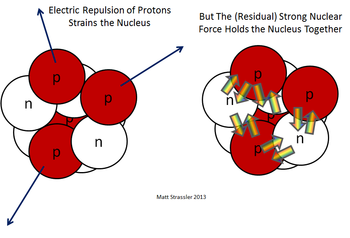Neutron

Neutrons are neutrally charged particles that are found in the nucleus of atoms, along with the positively charged protons. As you can see in figure 1, the protons are pushed apart by the electromagnetic force, but pulled together by the strong force, which is stronger at short distances (these distances are about a femtometer or 10-15 m). The strong force comes from the interactions among the protons and neutrons.[2] Neutrons are incredibly small, about 10-15 m, 10,000x smaller than an atom!
Please see size of the universe for some online demonstrations to show the scale of neutrons.
The number of neutrons in a nucleus determines what isotope the nucleus is. Some isotopes are stable and some aren't. The stability of isotopes depends on the ratio of protons to neutrons. If a nucleus has too many neutrons, it undergoes one type of beta decay and if has too few neutrons, it undergoes the opposite type of beta decay, see the bottom of the page for a PhET simulation about this stability. These decays are due to another force called the weak force.
Neutrons are made of smaller particles called quarks (or see hyperphysics for more on quarks), which also make up protons.
To learn more about neutrons please see hyperphysics.
Phet: Build a Nucleus
The Energy education team has adapted the following simulation from the University of Colorado. This simulation shows how neutrons and protons sit in energy levels and make up the nucleus. The number of neutrons and protons maintain particular ratios for the nucleus to be stable.
For Further Reading
To learn about the other nucleus, please see the following pages:
- Proton
- Weak nuclear force
- Strong force
- Fundamental force
- Or explore a random page
References
- ↑ Prof. Matt Strassler [Online]. Available: http://profmattstrassler.com/articles-and-posts/particle-physics-basics/the-structure-of-matter/the-nuclei-of-atoms-at-the-heart-of-matter/what-holds-nuclei-together/ [Accessed on 24 October 2014].
- ↑ Hyperphysics "Fundamental Force", Hyperphysics, 2018. [Online]. Available: http://hyperphysics.phy-astr.gsu.edu/hbase/Forces/funfor.html#c2. [Accessed: 19- Jun- 2018]

